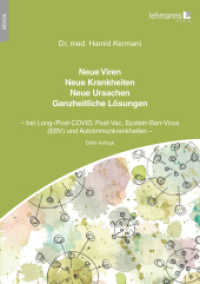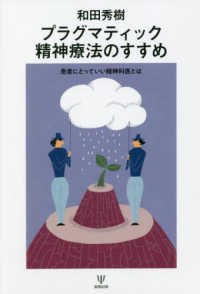Full Description
The Routledge Handbook of World Englishes constitutes a comprehensive introduction to the study of World Englishes. Split into six sections with 40 contributions, this Handbook discusses how English is operating in a wide range of fields from business to popular culture and from education to new literatures in English and its increasing role as an international lingua franca.
Bringing together more than 40 of the world's leading scholars in World Englishes, the sections cover historical perspectives, regional varieties of English from across the world, recent and emerging trends and the pedagogical implications and the future of Englishes. The Handbook provides a thorough and updated overview of the field, taking into account the new directions in which the discipline is heading. This second edition includes up-to-date descriptions of a wide range of varieties of English and how these reflect the cultures of their new users, including new chapters on varieties in Bangladesh, Uganda, the Maldives and South Africa, as well as covering hot topics such as translanguaging and English after Brexit.
With a new substantial introduction from the editor, the Handbook is an ideal resource for students of applied linguistics, as well as those in related degrees such as applied English language and TESOL/TEFL.
Contents
List of Contributors
Introduction
Section 1 Historical Perspectives and Traditional Englishes
1 Standardized English: The History of the Earlier Circles
2 Grammatical variation in the contemporary spoken English of England
3 Phonological innovation in contemporary spoken British English
4 The Englishes of Ireland: Emergence, Transportation and Current Trends
5 The development of standard American English
6 The Englishes of Canada
7 English in Australia
8 The English(es) of New Zealand
Section 2 Regional Varieties
9 The development of the English language in India
10 Sri Lankan Englishes
11 English in education in Bangladesh: World Englishes perspectives
12 East and West African Englishes: Differences and commonalities
13. Spread of English at the grassroots? Sociolinguistic evidence from two post-protectorates: Maldives and Uganda
14 South African Englishes
15 China English: a future power
16 Periphery ELT: Myths about English in the Philippines
17 English in Singapore and Malaysia Differences and Similarities
18 English in Japan
19 Slavic Englishes: education or culture?
20 West Indian English: An Introduction to Literature in Selected Varieties
21 English and English teaching in Colombia: Tensions and possibilities in the expanding circle
Section 3: Emerging Trends and Themes
22 English as a Lingua Franca in the European context
23 Developmental patterns of English: similar or different?
24 Mixed codes or varieties of English?
25 Semantic and pragmatic conceptualisations within an emerging variety: Persian English
26 Writing in Englishes 'In Defence of Foreigness'
27 World Englishes, Social Disharmonisation, and Environmental Destruction
Section 4 Contemporary Contexts, Functions and Variables
28 Online Englishes
29 The Englishes of Business
30 The increasing use of EMI in Higher Education
31 The Englishes of Popular Culture
32 World Englishes and Philippine call centres
33 Translanguaging and Multilingual Creativity with English in the Sinophone World
34 'Brexit' and the postnational dimension of English in Europe
Section 5: Debates and Pedagogical Implications
35 Variation across Englishes Phonology
36 English language teachers in context: Who teaches what, where and why?
37 When does an unconventional form become an innovation?
38 Which Test of Which English and Why?
39 Academic Englishes: A Standardised Knowledge?
Section 6: The Future
40 The Future of Englishes: one, many or none?
Index







